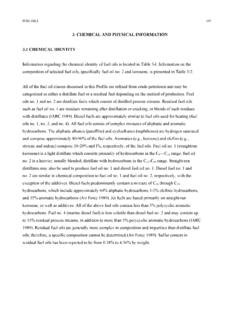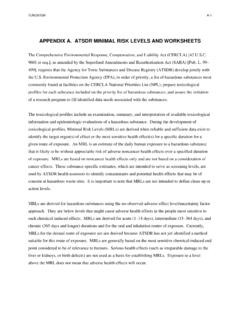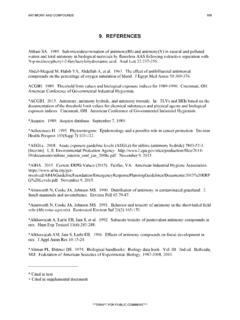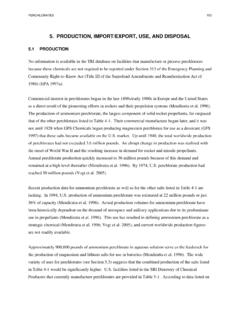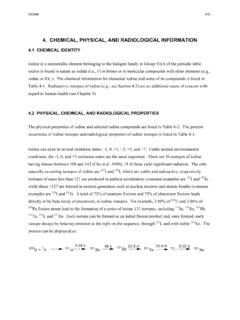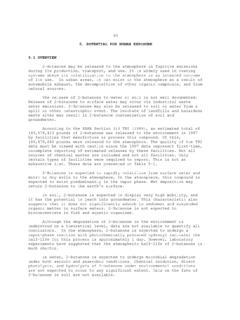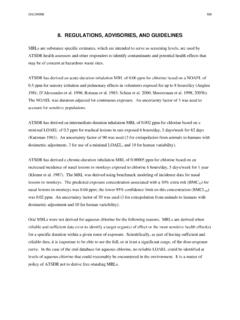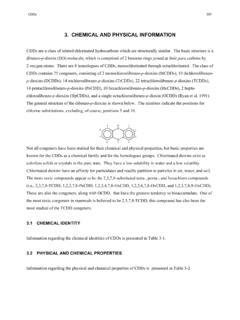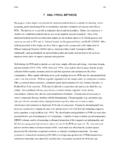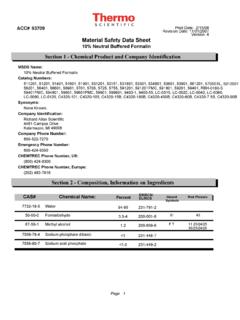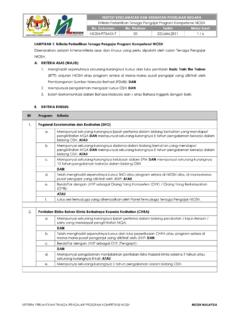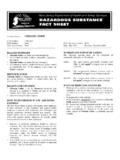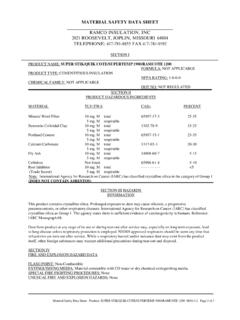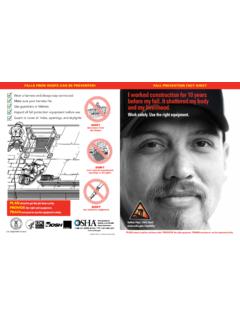Transcription of Toxicological Profile for Styrene
1 Toxicological Profile FOR Styrene DEPARTMENT OF HEALTH AND HUMAN SERVICES Public Health Service agency for toxic Substances and disease registry November 2010 ii Styrene DISCLAIMER The use of company or product name(s) is for identification only and does not imply endorsement by the agency for toxic Substances and disease registry . iii Styrene UPDATE STATEMENT A Toxicological Profile for Styrene , Draft for Public Comment was released in October 2007. This edition supersedes any previously released draft or final Profile . Toxicological profiles are revised and republished as necessary. For information regarding the update status of previously released profiles, contact ATSDR at: agency for toxic Substances and disease registry Division of Toxicology and Environmental Medicine/Applied Toxicology Branch 1600 Clifton Road NE Mailstop F-62 Atlanta, Georgia 30333 iv Styrene This page is intentionally blank.
2 FOREWORD This Toxicological Profile is prepared in accordance with guidelines* developed by the agency for toxic Substances and disease registry (ATSDR) and the Environmental Protection agency (EPA). The original guidelines were published in the Federal Register on April 17, 1987. Each Profile will be revised and republished as necessary. The ATSDR Toxicological Profile succinctly characterizes the toxicologic and adverse health effects infonnation for these toxic substances described therein. Each peer-reviewed Profile identifies and reviews the key literature that describes a substance 's toxicologic properties. Other pertinent literature is also presented, but is described in less detail than the key studies. The Profile is not intended to be an exhaustive document; however, more comprehensive sources of specialty information are referenced.
3 The focus ofthe profiles is on health and toxicologic infonnation; therefore, each Toxicological Profile begins with a public health statement that describes, in nontechnical language, a substance 's relevant Toxicological properties. Following the public health statement is infonnation concerning levels of significant human exposure and, where known, significant health effects. The adequacy of infonnation to detennine a substance 's health effects is described in a health effects summary. Data needs that are of significance to protection of public health are identified by ATSDR. Each Profile includes the following: (A) The examination, summary, and interpretation ofavailable toxicologic infonnation and epidemiologic evaluations on a toxic substance to ascertain the levels of significant human exposure for the substance and the associated acute, subacute, and chronic health effects; (B) A determination ofwhether adequate infonnation on the health effects of each substance is available or in the process of development to detennine levels ofexposure that present a significant risk to human health ofacute, subacute, and chronic health effects; and (C) Where appropriate, identification oftoxicologic testing needed to identifY the types or levels ofexposure that may present significant risk of adverse health effects in humans.
4 The principal audiences for the Toxicological profiles are health professionals at the Federal, State, and local levels; interested private sector organizations and groups; and members ofthe public. This Profile reflects ATSDR's assessment ofall relevant toxicologic testing and infonnation that has been peer-reviewed. Staffs ofthe Centers for disease Control and Prevention and other Federal scientists have also reviewed the Profile . In addition, this Profile has been peer-reviewed by a nongovernmental panel and was made available for public review. Final responsibility for the contents and views expressed in this Toxicological Profile resides with ATSDR. // 7\\ /);/A~-'0/. :../C~--(Xj Thomas R. Frieden, , Administrator agency for toxic Substances and disease registry "Legislative Background The Toxicological profiles are developed under the Comprehensive Environmental Response, Compensation, and Liability Act of 1980, as amended (CERCLA or Superfund).
5 CERCLA section 104(i)(1) directs the Administrator of ATSDR to " ..effectuate and implement the health related authorities" ofthe statute. This includes the preparation oftoxicological profiles for hazardous substances most commonly found at facilities on the CERCLA National Priorities List and that pose the most significant potential threat to human health, as determined by ATSDR and the EPA. Section 104(i)(3) ofCERCLA, as amended, directs the Administrator ofATSDR to prepare a Toxicological Profile for each substance on the list. In addition, A TSDR has the authority to prepare Toxicological profiles for substances not found at sites on the National Priorities List, in an effort to " ..establish and maintain inventory of literature, research, and studies on the health effects oftoxic substances" under CERCLA Section 104(i)(IXB), to respond to requests for consultation under section 104(i)(4), and as otherwise necessary to support the site-specific response actions conducted by A TSDR.
6 Vii Styrene QUICK REFERENCE FOR HEALTH CARE PROVIDERS Toxicological Profiles are a unique compilation of Toxicological information on a given hazardous substance . Each Profile reflects a comprehensive and extensive evaluation, summary, and interpretation of available toxicologic and epidemiologic information on a substance . Health care providers treating patients potentially exposed to hazardous substances will find the following information helpful for fast answers to often-asked questions. Primary Chapters/Sections of Interest Chapter 1: Public Health Statement: The Public Health Statement can be a useful tool for educating patients about possible exposure to a hazardous substance . It explains a substance s relevant toxicologic properties in a nontechnical, question-and-answer format, and it includes a review of the general health effects observed following exposure.
7 Chapter 2: Relevance to Public Health: The Relevance to Public Health Section evaluates, interprets, and assesses the significance of toxicity data to human health. Chapter 3: Health Effects: Specific health effects of a given hazardous compound are reported by type of health effect (death, systemic, immunologic, reproductive), by route of exposure, and by length of exposure (acute, intermediate, and chronic). In addition, both human and animal studies are reported in this section. NOTE: Not all health effects reported in this section are necessarily observed in the clinical setting. Please refer to the Public Health Statement to identify general health effects observed following exposure. Pediatrics: Four new sections have been added to each Toxicological Profile to address child health issues: Section How Can (Chemical X) Affect Children?
8 Section How Can Families Reduce the Risk of Exposure to (Chemical X)? Section Children s Susceptibility Section Exposures of Children Other Sections of Interest: Section Biomarkers of Exposure and Effect Section Methods for Reducing toxic Effects ATSDR Information Center Phone: 1-800-CDC-INFO (800-232 -4636) or 1-888-232-6348 (TTY) Fax: (770) 488-4178 E-mail: Internet: The following additional material can be ordered through the ATSDR Information Center: Case Studies in Environmental Medicine: Taking an Exposure History The importance of taking an exposure history and how to conduct one are described, and an example of a thorough exposure history is provided. Other case studies of interest include Reproductive and Developmental Hazards; Skin Lesions and Environmental Exposures; Cholinesterase-Inhibiting Pesticide Toxicity; and numerous chemical-specific case studies.
9 Styrene viii Managing Hazardous Materials Incidents is a three-volume set of recommendations for on-scene (prehospital) and hospital medical management of patients exposed during a hazardous materials incident. Volumes I and II are planning guides to assist first responders and hospital emergency department personnel in planning for incidents that involve hazardous materials. Volume III Medical Management Guidelines for Acute Chemical Exposures is a guide for health care professionals treating patients exposed to hazardous materials. Fact Sheets (ToxFAQs) provide answers to frequently asked questions about toxic substances. Other Agencies and Organizations The National Center for Environmental Health (NCEH) focuses on preventing or controlling disease , injury, and disability related to the interactions between people and their environment outside the workplace.
10 Contact: NCEH, Mailstop F-29, 4770 Buford Highway, NE, Atlanta, GA 30341-3724 Phone: 770-488-7000 FAX: 770-488 -7015. The National Institute for Occupational Safety and Health (NIOSH) conducts research on occupational diseases and injuries, responds to requests for assistance by investigating problems of health and safety in the workplace, recommends standards to the Occupational Safety and Health Administration (OSHA) and the Mine Safety and Health Administration (MSHA), and trains professionals in occupational safety and health. Contact: NIOSH, 200 Independence Avenue, SW, Washington, DC 20201 Phone: 800-356-4674 or NIOSH Technical Information Branch, Robert A. Taft Laboratory, Mailstop C-19, 4676 Columbia Parkway, Cincinnati, OH 45226-1998 Phone: 800-35-NIOSH. The National Institute of Environmental Health Sciences (NIEHS) is the principal federal agency for biomedical research on the effects of chemical, physical, and biologic environmental agents on human health and well-being.
